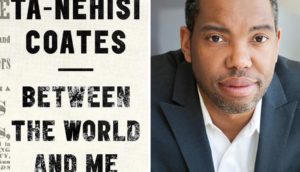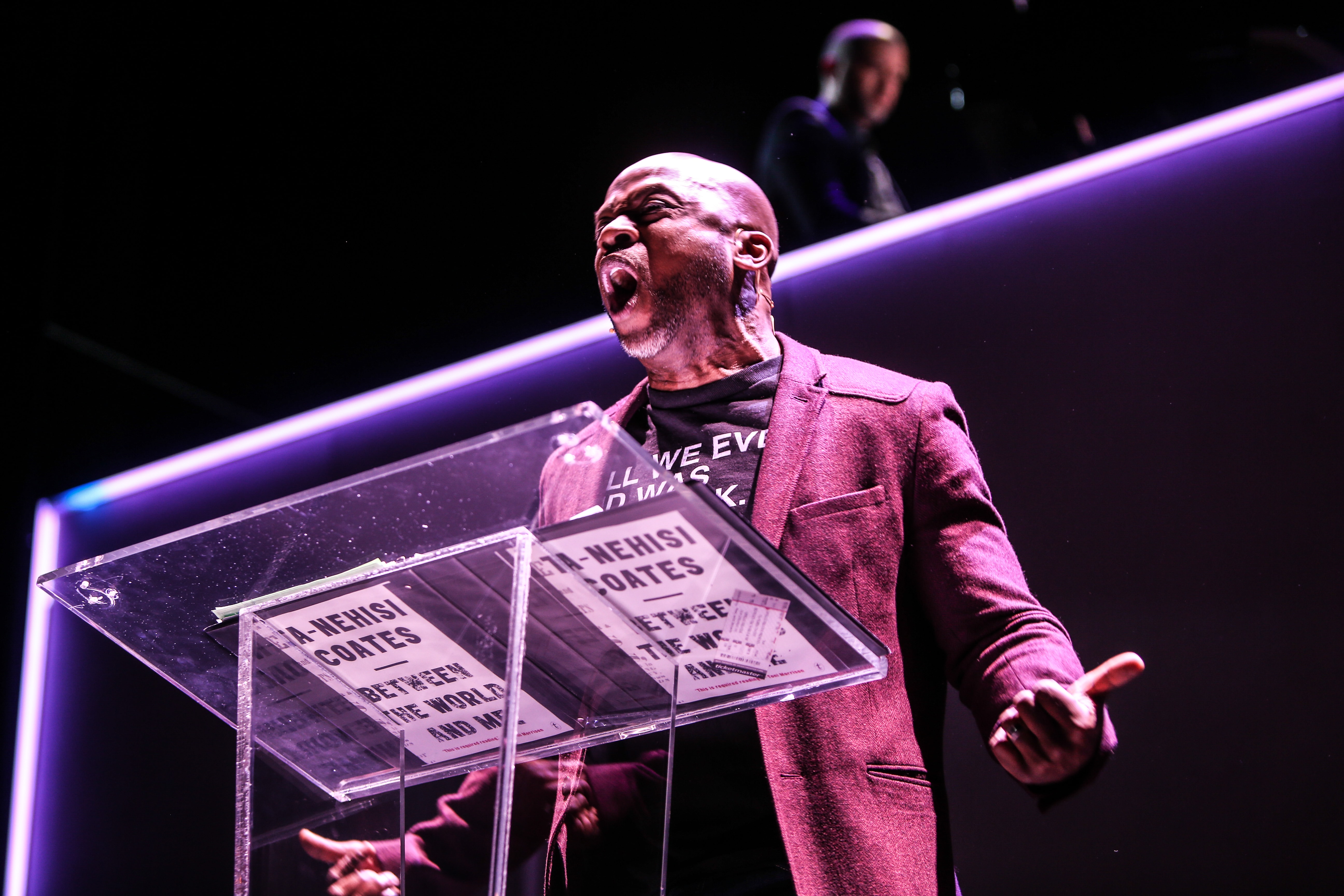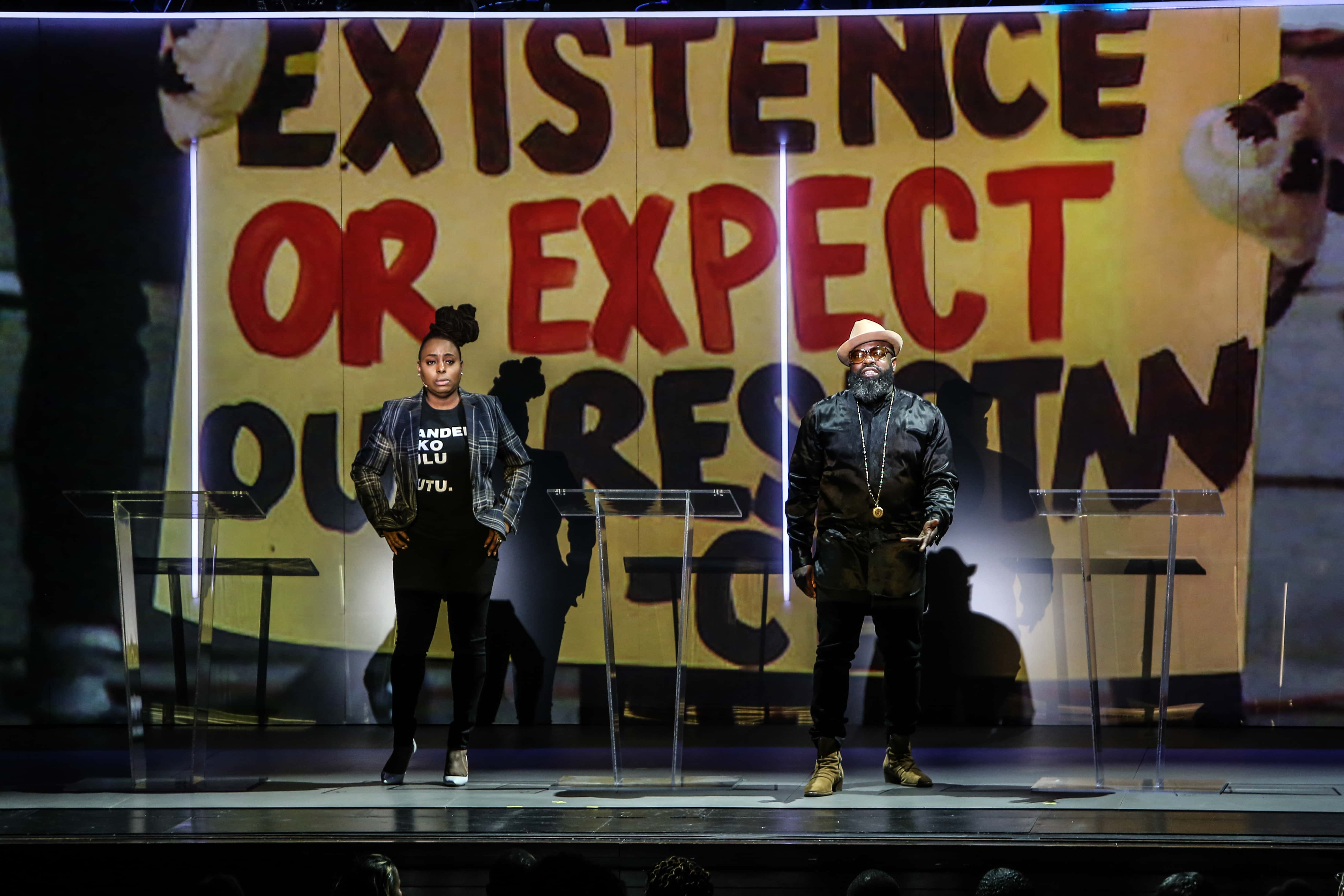Ta-Nehisi Coates’s son, Samori, was 15 when his father wrote a book addressed to him, Between the World and Me. Before that book won the National Book Award and was a Pulitzer Prize finalist, it was a heartfelt message to a boy whose father knew he could be shot dead for no reason except he was black. The pain and pride, the anger and anguish, the hope and helplessness Coates feels at this unjust prospect flow through the book like a flooding river of tears.

For me reading the book, through welling eyes of my own, was to experience a writer whose graceful command of language and cut-to-the-root political insight left me humbled and in awe. Coates is often compared, aptly, to James Baldwin, whose voice, especially in The Fire Next Time, resounds through Between the World and Me. And—of particular importance to me—Baldwin and Coates both articulate what it means to be white, with a conscience and clarity I almost never find in the work of white writers.
Throughout Between the World and Me, Coates refers to people, especially Americans, who “believe they are white.” At the very beginning, he tells of a TV news host in DC who
wished to know why I felt that white America’s progress, or rather the progress of those Americans who believe that they are white, was built on looting and violence. Hearing this, I felt an old and indistinct sadness well up in me. The answer to the question is the American believers themselves. The answer is American history.
Baldwin makes a similar point in an essay titled “On Being White…And Other Lies”:
America became white—the people who, as they claim, “settled” the country became white—because of the necessity of denying the Black presence, and justifying the Black subjugation. No community can be based on such a principle—or, in other words, no community can be established on so genocidal a lie. White men—from Norway, for example, where they are Norwegians—became white: by slaughtering the cattle, poisoning the wells, torching the houses, massacring Native Americans, raping Black women.
Coates began writing Between the World and Me shortly after Michael Brown was killed in Ferguson. Samori was born into the same world, a place where the boy’s black body could at anytime be destroyed in order to sustain someone’s belief in himself as white. Between the World and Me is propelled by Coates’s purpose to tell his son as much truth about that contingency as he can—knowing full well that, as he writes to Samori, “I can’t save you.”

The passion on the pages of the book became searingly and exhilaratingly present in the Eisenhower Theater at Kennedy Center when eight illustrious black artists read passages from it to a packed house Sunday afternoon. It seemed an audience not only of fans but of seekers, listeners eager and prepared to be moved and inspired by the truths they knew Coates had told.
The readers, all superb vocal artists, brought a full range of emotions and declaration from dirge to poetry slam. They included superstar tap dancer, choreographer, and actor Savion Glover; Hip Hop playwright Marc Bamuthi Joseph, librettist of the opera We Shall Not Be Moved; Emmy Award–winning actor Joe Morton (Scandal); actor/arts collaborator Greg Alverez Reid; rap artist Tariq “Black Thought” Trotter of The Roots; Broadway and film actor Pauletta Pearson Washington; This Is Us’s Susan Kelechi Watson; and 12-time Grammy Award–nominated singer Ledisi.
On a raised platform were a pianist (Jason Moran), a guitarist (Mimi Jones), and a drummer (Nate Smith) who intermittently enhanced the readings with exquisitely sensitive jazz accompaniments. These were composed for the occasion by Kennedy Center Artistic Director for Jazz Jason Moran, who also conducted. The full stage was emblazoned with projections designed by Tal Yarden with Five OHM Productions that began subtly situating the storytelling with indistinct patterns and became steadily more and more powerful, culminating in a furious montage of headlines about black bodies felled.

The passages chosen followed Coates chronologically from his youth in Baltimore, to his days at Howard University (and its yard called The Mecca), to his becoming a writer, to his meeting Samori’s mother, to their home in Brooklyn… The black body is a recurring theme. The essential below is another, meaning being the one who must be taken down by one who believes himself white. And a portion of the narrative from the book is told of Coates’s dear friend from Howard named Prince Jones who, Coates learned as he was writing the book, was shot and killed by a cop. Thereafter Coates pays a visit to Prince’s mother, Mrs. Jones, in a passage that aches with grief and courage.
The program was developed and directed by Kamilah Forbes, a friend of Coates’s from their days at Howard and now executive producer of New York’s Apollo Theater, which produced the performance in collaboration with the Kennedy Center. The show was first performed a week before at the Apollo. Now arrived in DC, the entire endeavor represented an extraordinary convergence of institutional resources and artistic talents, all focused on sharing the experience of a text so personal yet so political that it seemed to coalesce every heart in the house.

Surely this fine project should have a life beyond this brief run. I can even imagine that stripped down to its soul, simply the language and the writing, this beautiful adaptation of Between the World and Me by Lauren A. Whitehead could be done in readers’ theater productions on campuses across the country for years to come.
Names of the sections of the program were projected on the set (lighting design by Jane Cox, scenic design by Michael Carnahan), functioning as a visual table of contents for the topics and continuity of the storytelling. Following is a partial listing of the passages and artists who read each.
Son, I Write to You in Wisdom
Joe Morton
Young, Naked & Black in Baltimore
Tariq “Black Thought” Trotter
The Schools, the Streets. Arms of the Same Beast
Ledisi
The Malcolm Expansion: T and His Blooming Consciousness
Greg Alverez Reid/Michelle Wilson
Meeting the Mecca, In Awe, Wonder & Unapologetic Pride
Susan Kelechi Watson
Becoming a Writer, Curiosity, and Vertigo
Marc Bamuthi Joseph, Michelle Wilson, Greg Alverez Reid, Pauletta Pearson Washington
All These Women & You, a Romance
Marc Bamuthi Joseph
Lessons to Samori
Joe Morton
Pulled Over in PG County, in Fear
Savion Glover
The Mystique of Prince Jones (We Know)
Greg Alverez Reid
I Imagined Myself Like Prince (Think of All)
Joe Morton
Fire for the Rest of My Days
Marc Bamuthi Joseph
Damn It All, a Sorrow Song with Whiskey Glass
Michelle Wilson
Aimless & on Guard in Brooklyn
Tariq “Black Thought” Trotter
The Escalator Story: Ta-Nehisi and His Rage
Joe MortonSusan Kele, chi Watson
It Had to Be Blood, a Folklore
Marc Bamuthi Joseph
My Eyes, These Doors, Forged in Shadow
Pauletta Pearson Washington
Long Live the Struggle: Ta-Nehisi and the Voices of the Collective
Joe Morton, Greg Alverez Reid, Marc Bamuthi Joseph,Michelle Wilson, Black Thought
The Void Speaks Back, a Moment with Dr. Jones
Greg Alverez Reid, Pauletta Pearson Washington (as Dr. Jones)
The Final Wisdom, a Joy

At the very end, after the cast and musicians had been vigorously applauded, names began to appear projected on the set. The audience getting ready to leave the theater instead stopped still, stood hushed, somberly watching and reading as countless names scrolled upward, names upon names of black bodies shot down, names Coates knew his son could be among, black bodies some there could have known. It was a powerful tribute to a collective sorrow that as yet knows no end.
Running Time: One hour 40 minutes, with no intermission.
Between the World and Me played twice on April 7, 2018, at the John F. Kennedy Center for the Performing Arts Eisenhower Theater — 2700 F Street, NW in Washington, DC.




